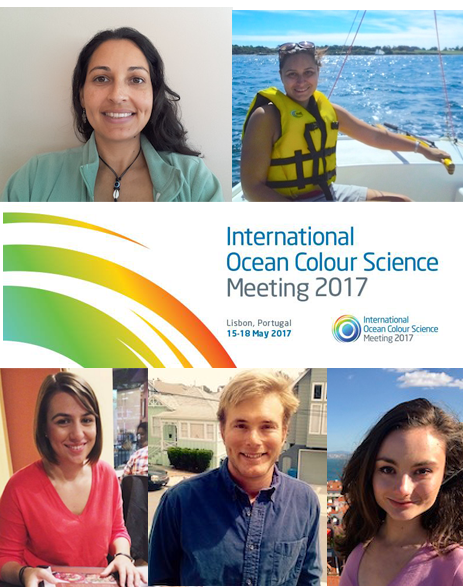OCB-sponsored participants of 3rd International Ocean Color Meeting in May 2017.
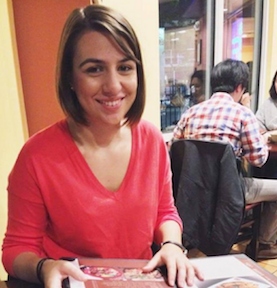 Christiana Ade is a first-year PhD student at North Carolina State University in the Marine, Earth and Atmospheric Sciences Department. She researches wetlands and coastal environments using satellite remote sensing and field measurements. Her research includes water quality mapping, establishing new environmental indicators, and determining satellite resolution requirements for adequately monitoring wetlands.
Christiana Ade is a first-year PhD student at North Carolina State University in the Marine, Earth and Atmospheric Sciences Department. She researches wetlands and coastal environments using satellite remote sensing and field measurements. Her research includes water quality mapping, establishing new environmental indicators, and determining satellite resolution requirements for adequately monitoring wetlands.
“As a master’s student, I focused on wetland vegetation, but for my PhD I am shifting toward water quality monitoring. The 2017 IOCS meeting occurred at a critical time in my career as I begin this research transition. IOCS allowed me to meet several prominent researchers and advanced students that I foresee myself collaborating with in the future, thus furthering my long-term objective of becoming a researcher in a national lab or university professor. I presented a poster at IOCS on some preliminary research and received extremely useful feedback, which I am already implementing. Although the conference was great for networking, it was most beneficial for expanding my understanding of current limitations and future opportunities in remote sensing of water. In particular, the breakout sessions provided me with several insights on hot-button topics and gave me confidence that the ocean color community will aid researchers invested in coastal applications to determine what sensor resolutions are needed to monitor these environments. Meetings like this ensure that the necessary technology gets built and launched. I would like to thank all the organizers, speakers, and the OCB for their positive impact on my research career.”
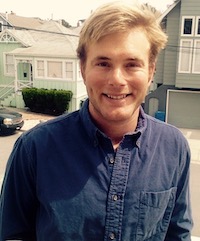 Henry Houskeeper is a third year Ocean Sciences PhD student working with Raphael Kudela at the University of California, Santa Cruz. Henry investigates the optical properties of dinoflagellate red tides. His broader interests include remote sensing of the coastal ocean, coastal upwelling ecosystem dynamics, and phytoplankton ecology.
Henry Houskeeper is a third year Ocean Sciences PhD student working with Raphael Kudela at the University of California, Santa Cruz. Henry investigates the optical properties of dinoflagellate red tides. His broader interests include remote sensing of the coastal ocean, coastal upwelling ecosystem dynamics, and phytoplankton ecology.
“Attending the IOCS meeting was an excellent opportunity for me to receive thoughtful feedback on my research. IOCS connected me with helpful members of the ocean color community and exposed me to a diverse assemblage of ocean color research projects. The support from OCB made this valuable experience possible for me.”
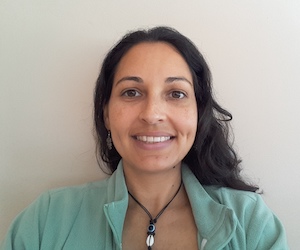 Suhey Ortiz Rosa is a PhD student conducting research with Dr. Roy Armstrong in Bio-Optical Oceanography at the Department of Marine Sciences at the University of Puerto Rico- Mayagüez (UPRM). In 2005, she completed a B.S. in Coastal Marine Biology at the University of Puerto Rico- Humacao, and in 2010, a MS in Chemical Oceanography at UPRM. Suhey’s work focuses on the biogeochemistry of coastal waters and coral reefs, validating algorithms from satellite imagery of complex optical waters, remote sensing, and GIS. Previously, she worked on CDOM characterization with PARAFAC, mapping marine species distribution with the GAP-Analysis Project of Puerto Rico and later with watershed analysis of sedimentation processes on coral reefs.
Suhey Ortiz Rosa is a PhD student conducting research with Dr. Roy Armstrong in Bio-Optical Oceanography at the Department of Marine Sciences at the University of Puerto Rico- Mayagüez (UPRM). In 2005, she completed a B.S. in Coastal Marine Biology at the University of Puerto Rico- Humacao, and in 2010, a MS in Chemical Oceanography at UPRM. Suhey’s work focuses on the biogeochemistry of coastal waters and coral reefs, validating algorithms from satellite imagery of complex optical waters, remote sensing, and GIS. Previously, she worked on CDOM characterization with PARAFAC, mapping marine species distribution with the GAP-Analysis Project of Puerto Rico and later with watershed analysis of sedimentation processes on coral reefs.
“The International Ocean Color Science Meeting was a unique experience. Networking with the international community to address common issues on satellite imagery analysis benefits my research tremendously. I am now able to communicate with leading experts that work with the latest processes, allowing me to conduct more accurate and efficient research. The workshop on Copernicus Data was also very helpful, providing hands-on personalized experience. The cultural diversity and different research projects presented made this conference an advantage for me as an early career ocean color researcher. The information I obtained expands my options for new opportunities and ideas in research. It is fundamental for young scientists to remain up to date with the innovations in their current research topic. Thanks to the OCB program for making this experience possible!”
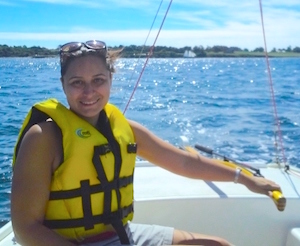 Sara Rivero-Calle is a postdoctoral researcher at the Levine Lab in the University of Southern California interested in projects that involve large datasets, combining remote sensing and in situ data to answer large-scale ecological questions. She first learned about satellite remote sensing during her MS program at the University of Puerto Rico working on mesophotic reef sponge ecology using Autonomous Underwater Vehicles. She earned a PhD from Johns Hopkins University, where she used the Continuous Plankton Recorder survey to study long-term changes in North Atlantic phytoplankton communities. Currently, Sara is conducting postdoctoral research on fine-scale variability and patchiness, combining remote sensing, float, and HPLC data with numerical models.
Sara Rivero-Calle is a postdoctoral researcher at the Levine Lab in the University of Southern California interested in projects that involve large datasets, combining remote sensing and in situ data to answer large-scale ecological questions. She first learned about satellite remote sensing during her MS program at the University of Puerto Rico working on mesophotic reef sponge ecology using Autonomous Underwater Vehicles. She earned a PhD from Johns Hopkins University, where she used the Continuous Plankton Recorder survey to study long-term changes in North Atlantic phytoplankton communities. Currently, Sara is conducting postdoctoral research on fine-scale variability and patchiness, combining remote sensing, float, and HPLC data with numerical models.
“Attending IOCS was a fantastic experience. I was invited to give a talk on the global distribution of Trichodesmium for the special session on Trichodesmium. This was a great opportunity, not only for the exposure, but also because I am now collaborating with the organizers on writing a white paper with recommendations for remote sensing of Trichodesmium from space. This is perfect timing, given the new sensors with higher spatial and spectral resolution currently being developed and forthcoming satellite missions. I also noticed a clear interest in the remote sensing community to work closely with modelers and I think I can help bridge the two communities. I will be collaborating with another working group focused on carbon cycling. One of the things I liked most was the IOCS meeting structure—splitting us up into working groups, identifying current challenges and brainstorming together on how to deal with them and move forward. This meeting is not focused on presenting work but on setting new goals and working towards them. I also liked that the IOCS meeting facilitates direct communication with program managers and representatives from all space agencies and how the agencies came to the meeting to hear what the scientific community needs to advance satellite remote sensing. In summary, the IOCS meeting is the perfect venue for international scientific networking and I am so grateful to OCB for supporting us at an early stage of our career, thanks for believing in us!”
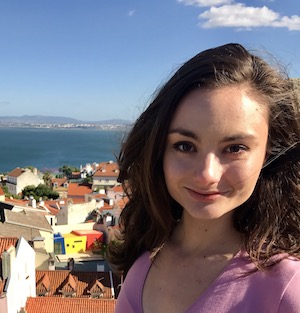 Sarah Schlunegger is a PhD Student in the Program of Atmospheric and Oceanic Sciences, advised by Prof. Jorge Sarmiento. Sarah uses Earth System Models to predict the timing, sequence and inter-dependence of emerging anthropogenic signals in the ocean, with a focus on the ocean’s acquisition of anthropogenic carbon and heat. The ocean provides a climate service by absorbing the atmosphere’s excess carbon and heat but at a cost, namely acidification and warming, which deteriorate marine habitats. Sarah’s primary research goal is to identify when and where changes in these heat/carbon sinks and their resulting impacts will be detectable in the ocean.
Sarah Schlunegger is a PhD Student in the Program of Atmospheric and Oceanic Sciences, advised by Prof. Jorge Sarmiento. Sarah uses Earth System Models to predict the timing, sequence and inter-dependence of emerging anthropogenic signals in the ocean, with a focus on the ocean’s acquisition of anthropogenic carbon and heat. The ocean provides a climate service by absorbing the atmosphere’s excess carbon and heat but at a cost, namely acidification and warming, which deteriorate marine habitats. Sarah’s primary research goal is to identify when and where changes in these heat/carbon sinks and their resulting impacts will be detectable in the ocean.
“As a climate modeler, I have limited daily interactions with observationalists, despite my using satellite observations as a component of my own research. The 2017 International Ocean Colour Science Meeting was the perfect platform to cure this condition! Hearing talks and discussion from the lead scientist and engineers who have spent decades developing and perfecting satellite observation platforms has expanded my understanding and appreciation for the work behind the end-product. I enjoyed listening to the expert panels parse through upcoming innovations to address atmospheric correction, a major challenge faced by the community. The fellow conference attendees were friendly and encouraging, and of course, Lisbon is a magical city!”

